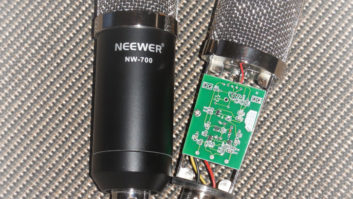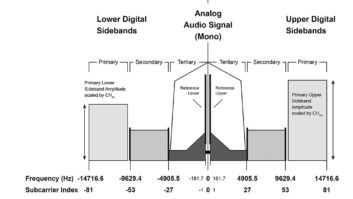We left our story about the history of wire and cable (RW, Sept. 1) with Bell Labs testing thousands of cables of different impedances.
They wanted to know, “Is there an ideal impedance for attenuation? Is there an ideal impedance for power handling? Is there an ideal impedance for high voltage?”
To their surprise, as you can see in Fig. 1, the results for each requirement were quite different.
You will note, for instance, that attenuation gets lowest around 77 ohms and rises on either side of that value. Because this value dictates the relationship of the dimensions of the cable, this calls out the ratio of sizes. That is, if you choose a center conductor, and the material (dielectric) around it (their original dielectric was air), then the distance to the outer conductor (shield) and the overall diameter of the cable are pre-determined.
(click thumbnail)Fig. 1: Coax Impedance and Loss
Likewise, if you want to build a cable of a specific impedance, you already know the diameter and you have chosen the dielectric inside, the size of the center conductor is pre-determined.
But that’s not all they found.
You will note that, while 77 ohms was the best number for attenuation, this is an odd ratio. If you change it slightly to 75 ohms (with a very small increase in attenuation), you can use standard-gage wires. Thus 75-ohm coax was born.
This is why all those coaxes intended to carry signals, not power, not high voltage, are 75 ohms. Cables like baseband video cable, CATV/broadband cable, are all 75 ohms. But for coaxial cables meant to carry high power, as you can see, an impedance of 30 ohms was required.
And therein lies a story.
Inefficiencies in scale
Once upon a time, when I was a young (read: ignorant) wire salesman, I had a customer at Lawrence Berkeley Laboratories. This is part of the University of California Berkeley, where they do pure research. My customer was building an atom smasher which, he told me, would allow him to look back almost to the moment of the Big Bang!
This machine was huge, probably a hundred feet long. Now, you know me, the Star Trek fan. I was entranced.
All he needed was 30-ohm coax. So I talked to our factory people. “Make some 30-ohm coax!” I said.
“Well,” said our grizzled factory engineer, “That’s all well and fine, but we’d have to throw most of it away.”
“Why?” I demanded. I was told that the ratio of sizes called out by this impedance is extremely difficult to make.
“We could make it,” said the engineer. “But we would probably throw 90 percent of it away.”
I reluctantly told the customer. His response? “Fine. Make 10 times as much as I need. Throw away the 90 percent that’s bad and send me the rest. And I’ll pay for it all.”
(Turns out he had painted himself into a corner and didn’t have an alternative. All the other cable manufacturers had turned him down flat.)
So we did! An interesting side note: we recently made some 30-ohm coax for another customer. This time, we only threw away 10 percent. Wow. We’re getting better!
Our previous column mentioned that research by Lloyd Espenschied and Herman Affel at Bell Labs in 1929 showed that 75 ohms was the ideal impedance for low-loss (low attenuation) coaxial cable, and 30 ohms was the ideal impedance for high-power coax. They also determined that, for high voltage, you will need 60-ohm coax.
Here is the dilemma for broadcasters. You want a cable that can handle high voltage and high power. This is where 50-ohm coax comes from. It is a compromise between voltage and power.
In fact, the first transmission-line coaxial cables were made by taking small copper pipe and putting it inside large copper pipe. If you do this with standard sizes of copper pipe, you will get impedances like 51.5 ohms or 52 ohms. That was close enough for government work. All you had to do was tune your transmitter and antennas to match. In fact, RCA standard transmission line was 51.5-ohm coax for almost four decades.
Speaking of transmitters: Our solid-state IC transmitters of today no longer require a compromise for high voltage. What you really need is 30-ohm cable, good for high power but not high voltage. Of course, your transmitter would have to be tuned to 30 ohms, and your antenna had better be 30 ohms. But you could probably increase efficiency. Too bad 30-ohm cable is so hard to make.
What’s Waldo up to?
The 1920s were full of major research and breakthroughs. Much of the early work on television was done in those years. And, in wire and cable, some new insulations began to become available.
You may recall in a previous column the scare that occurred during World War I when someone figured out that the Germans could have cut off our entire supply of rubber by simply blockading Central and South America.
Luckily, this never happened, or almost all the insulated wire, and all the tires, would have been impossible to make. It is no wonder, then, that there was a major push in the 1920s to invent “artificial” rubber, to reduce our dependency on tree rubber. All the rubber companies were given this project. One of them was B.F. Goodrich.
Working for Goodrich was a recent University of Washington graduate, Waldo Semon. He had done papers and other research on the petroleum industry. So he went to them and said, in effect, “What do you throw away? After you make all the kerosene, gasoline and other useful stuff, you throw away a bunch of things. What are they?”
Realizing that they could make money off the byproducts they threw away, petroleum companies were only too happy to send Waldo a sample of everything they discarded. Among them were gases ethylene and propylene.
Waldo knew that, to mimic rubber, he had to create long molecules called “monomers.” In experimenting with these gases, he eventually produced “ethylene-propylene-diene-monomer,” more commonly known by its initials, EPDM. This was the first artificial rubber.
When World War II rolled around, we were no longer dependent on natural rubber. EPDM is still put on wires. It is still “cured” like natural rubber. It is still “thermoset” so it can’t be recycled like plastics. But it has many of the ruggedness and wear properties of natural rubber.
Is inventing EPDM, which saved his country, good enough for Waldo Semon? Of course not. The next thing he made was even more amazing. We used over 90 billion pounds of it last year. Know what it was? Tune in next time!
Steve Lampen’s latest book, “The Audio-Video Cable Installers Pocket Guide” is published by McGraw-Hill. Reach him via e-mail to [email protected]








